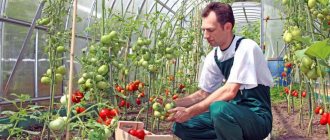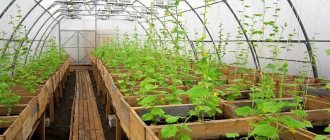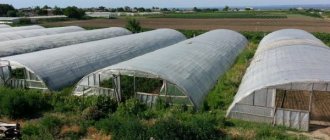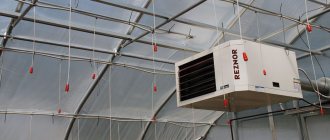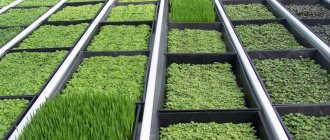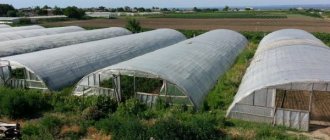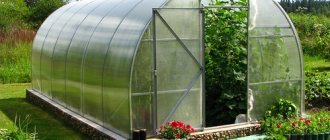Author of the article: Sudakov A.P.
A modern and properly built greenhouse will allow you to grow vegetables, herbs, berries and receive predictable yields from early spring to late autumn. Typically, greenhouses are created by gardeners in order to provide themselves and their families with environmentally friendly and natural products. But in this article we will consider the option of building a winter greenhouse as a business with high profitability, affordable investments and low time investment. A similar business can be organized both in a village and on a summer cottage - a standard six acres will be enough to make a stable profit.
Greenhouse business at home: profitable or not?
Growing vegetables, flowers and other products in greenhouses has many advantages that make this type of business attractive to beginners. Among them:
- relatively low cost of entry;
- ability to work with a wide variety of cultures;
- short payback periods;
- good demand for quality products.
When planning to start a greenhouse business, you need to take into account the difficulties. These include:
- high costs for heating greenhouses;
- difficulties with implementation;
- Working with a perishable product guarantees a high percentage of defects.
What to grow in a greenhouse for sale?
In greenhouses you can grow any crops, from common lettuce to exotic indoor plants. Novice plant growers prefer tomatoes and cucumbers; these vegetables are the easiest to sell. However, experts assure that the most profitable option is flowers. Second place is occupied by a variety of greens, and vegetables are in an honorable third.
It's a good idea to grow strawberries in a greenhouse. This berry has good yield and is always in stable demand. It is also possible to work with eggplants, radishes, asparagus, and exotic fruit plants.
The task of greenhouse farming is to provide consumers with crops that are difficult to buy in late autumn, winter and spring.
Growing seedlings for sale can also be a separate line of income. Experts do not recommend planting seasonal vegetables and root crops in greenhouses. Beets, carrots and similar crops have good shelf life; the harvest harvested in the fall survives safely until spring.
Experts recommend choosing crops with a short ripening period. In one greenhouse you can grow several types of plants or alternate them. Only hybrid self-pollinating varieties are suitable for greenhouses and greenhouses.
You can find out what kind of business you can open with minimal investment and how to make money growing greens here.
What to grow in a greenhouse for sale?
Soil insulation
In order for a self-made year-round greenhouse, in addition to the comfortable cultivation of vegetables and herbs, to help save as much as possible on its heating, it is recommended to insulate the soil. This procedure involves separating the fertile layer of the earth from those that are lower and colder. There are several methods to achieve this result. Here is one of the most used:
- Mark out the future location of the beds;
- In their place, they dig a pit with a 60-centimeter depth and cover the bottom with a 5-centimeter layer of sand;
- The insulation boards are laid out in such a way that the joints can be aligned;
- A 10-centimeter layer of expanded clay is poured onto the insulation so that it cannot be damaged during work with the ground. Expanded clay also plays a drainage role;
- Fill the pit with fertile soil or organize a warm bed.
If winters in your area are quite frosty and there is a lot of snow, you can make the bottom of the building from wood, brick or foam concrete. This will allow you to achieve even better thermal insulation.
Types of greenhouses: what should a beginner choose?
You can build greenhouses for growing plants yourself, but more often specialists are invited to build them. There are many modifications that differ in shape, size, materials and other features:
- The simplest option is an unheated greenhouse. It is suitable for growing early ground vegetables and seedlings. A greenhouse will protect plants from cold snaps at night and the first frosts, but it is not suitable for use in winter.
- The partially heated greenhouse guarantees a temperature of at least 5 degrees, which is suitable for growing seedlings of flower crops and heat-loving exotic plants.
- The most reliable all-season option is a winter heated greenhouse. This design is equipped with a heating system that prevents the temperature from falling below 13 degrees. In such a greenhouse you can grow any, even the most heat-loving vegetables and berries, herbs, flowers, and seedlings.
The type of greenhouse is also influenced by its shape. Experts identify three categories that are most common:
- Wall-mounted. The structure is attached to the house so that one wall is common. This device makes it possible to save on heating costs, but significantly limits the size of the greenhouse. Ideal for a winter garden, enclosed veranda or greenhouse.
- Arched. A popular design in which it is convenient to grow vegetables, herbs, and flowers. This form is most often used for greenhouses and partially heated greenhouses.
- Sloping. A house-shaped greenhouse is suitable for growing tall and climbing plants.
The glazed pitched roof provides good lighting and additional heating; in winter, snow does not linger on it.
Depending on the internal structure of the greenhouse there may be:
- Rackable. Shelves are mounted on the side walls, on which plants planted in pots and boxes are placed in tiers. Often used when growing hydroponically (in a liquid nutrient solution).
- Ground. In this case, ridges are organized in the greenhouse, and plants are planted in rows in prepared soil. For such greenhouses, heating using a cable laid underground is desirable.
How to open a pet store: step-by-step instructions and a business plan are in our new publication at the link.
Equipment and heating
It is important to understand that any crop grown in winter in greenhouse conditions requires careful handling, since it will be much weaker than its seasonal counterpart. Particular attention should be paid to the soil, no matter what you plant in it. The composition of the soil should be balanced and rich in minerals and fertilizers. It is worth noting that the established concentration should be strictly adhered to, since excess nutrients harm the plants and they can “burn out.”
The climate zone you have chosen for the construction of the structure also requires special attention. If the air temperature is below 5 degrees, then the greenhouse needs to be insulated or even a heating system installed. The following can be used as heaters:
- Boilers using coal, fuel oil or wood.
- Heaters.
- Gas boilers with heating catalyst vessels.
- Buleryans.
There is also the option of connecting the greenhouse to a home steam heating system. All of the above options have one common drawback - the lack of uniform heat distribution; according to the laws of physics, it is collected at the top of the structure, and its lower part is not fully heated.
The arrangement requires not only heating, but also additional lighting.
To grow crops in greenhouse conditions, special lamps are produced that emit the spectrum necessary for photosynthesis. Such lamps are not particularly expensive, but they are difficult to install. Energy-saving mercury, fluorescent and LED lamps are also suitable for lighting.
It is also necessary to prepare beds in the greenhouse with a height of at least 20 centimeters from fertile soil and humus. You will have to install a special irrigation system, although you can water it manually.
You can see the arrangement of such a structure in Siberia in the following video:
How to build a winter greenhouse with heating with your own hands?
Before you start building a winter greenhouse, you need to calculate its dimensions. They depend on the number of plants that are planned to be planted. To begin with, it is recommended to build a greenhouse of 120-130 square meters. meters. In the future, the building can be expanded or another structure can be erected nearby.
Winter greenhouses, unlike conventional greenhouses, are installed on a foundation. The frame is firmly fixed with self-tapping screws. The more reliable the foundation, the more durable the greenhouse will be.
It is recommended to place it in the direction from north to south, this will ensure optimal light conditions.
The most profitable and durable material for the frame is polycarbonate. It does not deform, does not crack, and tolerates excess moisture and temperature changes. A wooden frame is also possible, but it has two major disadvantages: high price and fragility.
It is also worth using durable and aesthetic polycarbonate as a covering stretched over the frame. This material is snow-resistant, not too fragile, and transmits sunlight well. Glass can crack under the weight of snow or burst from frost, and inexpensive film will have to be replaced before the start of each season.
In the greenhouse it is necessary to make doors and a ventilation system for ventilation, and install electric lighting. But the most important question is proper and most economical heating.
How to make a pond at your dacha with your own hands step by step, and what materials and equipment will be required for construction - find out at the link.
How to build a winter greenhouse with heating with your own hands: step-by-step instructions.
Organization of heating
A greenhouse can be heated in a variety of ways. The choice depends on its size, climate characteristics and your financial capabilities.
The cheapest option is biofuel. To create it, horse, cow or pig manure is taken, mixed with compost or straw in equal proportions, and then spilled with water. After 2-3 days the mixture will begin to generate heat.
The layer of soil in the greenhouse is removed, a layer of biofuel is laid under it, and fertile soil is placed on top. Biofuel works for up to 3 months, providing a temperature in the greenhouse of 15 to 20 degrees.
There are also technical methods of heating. To create the optimal temperature you can use:
- steam heating;
- gas heating vessels;
- heating or infrared cables;
- potbelly stoves;
- heaters.
Many greenhouse owners successfully combine several types of heating. This approach guarantees the desired temperature even in the harshest winters.
How to warm
Various options are used for heating: stoves, boilers, electrics, etc. Let's consider several of the most popular options:
- Classic solid fuel (wood, coal, pellets, sawdust, peat) and air heating method. Buleryan or its equivalent is installed in the greenhouse, the hot air supply hoses are opened and the operation of the stove is monitored. One bookmark in the buleryan is enough for 6-10 hours, so you will have to adapt to the operation of the system - if you forget to add firewood and the flame goes out, then after a few hours the structure will cool down and the plants will die. Buleryan is usually placed in the center so that air flows evenly over the entire area.
- Solid fuel and water heating. Pipes with radiators or registers are stretched along the perimeter of the frame, and a boiler is placed at the entrance. The boiler heats the water in the expansion tank; due to the difference in height, it moves through the pipes and heats the air in the greenhouse. The efficiency of such a system is higher than that of an air system, and the inertia of the system is greater, especially if you use cast iron radiators. One way or another, you will have to monitor the supply of solid fuel, but due to the high inertia, the greenhouse will not freeze even if the flame goes out for a couple of hours.
- Using gas or diesel fuel for water heating. The same system is created as in point 2, but instead of firewood, gas or diesel fuel from the tank is used. In this case, there is no need to monitor the burning of solid fuel.
- Electric heating based on the “warm floor” principle. An electrical cable is laid between the plants. When turned on, it heats up, warming the soil and air by convection. Such a system allows you to automate the heating process, but the costs of its creation will be quite significant.
Heating a winter greenhouse with an electric convector
There are other heating schemes - a greenhouse is “parallelized” with a house boiler, an air heating system is created (a fire burns outside, warm air from which is supplied inside), infrared emitters are installed that warm the surface and the plants themselves.
Attention:
The heating issue must be thought through in advance. If you want to automate the process, then choose gas or electricity. If you are constantly present on the site, then you can use firewood or pellets - in most regions of Russia this will be cheaper than gas and electricity due to the availability of raw materials.
Winter greenhouse as a business: legal details of registration
The easiest way for beginning vegetable growers is to register as an individual entrepreneur. This makes it possible to sell products not only on the market, but also to offer them to various retail outlets. It is recommended to choose a simplified form of taxation.
If you plan to build several greenhouses, you can register a farm. This form allows access to loans and subsidies, but requires more complex documentation.
What documents will be required to register an individual entrepreneur and how to prepare them correctly, you can read here.
Winter greenhouse as a business: how to sell products?
Sales of finished products
The owner of a greenhouse or greenhouse farm will have to carefully consider the issue of selling products. Grown vegetables, berries and herbs can be:
- sell on the market independently or through a hired seller;
- hand over for sale to a grocery store or supermarket;
- sell to wholesale buyers;
- offer to restaurants and cafes;
- sell through an online store or agricultural cooperative.
The most profitable option is independent retail sales. Wholesalers purchase products at the minimum price, and stores cannot guarantee the sale of the entire batch taken. The returned balances will have to be added to the losses.
Owners of several greenhouses, faced with the need to sell a large harvest, should buy a machine for prompt delivery of products to customers, as well as hire a manager who will search for new sales channels.
How to open a flower shop from scratch and draw up a competent business plan with calculations - read in this article.
Where to sell
You need to think about where you will sell your products before they grow. Usually all this is calculated and thought through at the stage of drawing up a business plan. There are several options here:
- Deliver products to small stores located in residential areas.
- Opening your own farm store (and later expanding to a full-fledged chain).
- Deliver products to markets, sell them among friends, relatives, and colleagues.
- Conclude an agreement with supermarkets or bases.
For beginners, the option with markets, small stores and friends is suitable - you will sell small batches until you can get on stream. Then you need to strive to get into supermarkets - they buy everything in bulk, offering interesting terms of cooperation.
Winter greenhouse business plan
A greenhouse business does not require excessive investments. You can start with the construction of one greenhouse, gradually expanding and improving the economy.
At the initial stage you will have to spend:
- for the construction and equipment of a greenhouse (about 120 sq. m) - 200,000 rubles;
- for the purchase of planting material, fertilizers, fuel - from 30,00 rubles per month
Business plan for a winter greenhouse with calculations.
Greenhouse as a business: profitability and payback period
When growing vegetables or herbs in such a greenhouse, it is possible to make a profit of 100,000 rubles per month. Thus, a single structure will pay for itself in 2 seasons. Business profitability is about 70%.
A winter greenhouse as a business requires a careful approach and a sensitive response to market fluctuations. Be prepared to change direction by choosing more popular crops. Mobility, entrepreneurship and the absence of stereotypes in matters of implementation will allow you to quickly achieve success.
Winter greenhouse as a business: video with professional recommendations
Don't forget to add "FBM.ru" to your news sources
Last news

